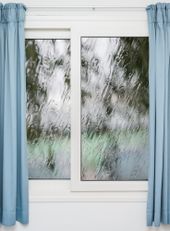
Humidity, rainfall, seasonal changes, and decaying leaves or wood can create the perfect environment for mold to grow in parts of your home or on your windows. Contrasts between a warm indoor temperature and the outdoors,combined with drywall or rotted wood in your window sill can speed the process. However, there are steps you can take to protect your windows from mold and help keep your home healthy and mold-free.
Minimize Condensation
Mold needs an appropriate temperature, moisture and decaying organic material to survive. The easiest and most effective way to control mold growth in your home is to reduce the level of moisture. Reducing humidity and increasing ventilation will lead to less condensation on your windows, making them a less hospitable environment for mold spores.
 A few simple steps will reduce a good amount of the humidity that can build up in your home. For example, use exhaust fans to draw moisture from the air, especially when showering or running warm bath water. Clothes dryers and gas burners should have vents to the outdoors. Avoid running a humidifier in your home when possible. Vents in your basement or attic should always be open. When weather permits, open a window or two to air out your home for a little while each day.
A few simple steps will reduce a good amount of the humidity that can build up in your home. For example, use exhaust fans to draw moisture from the air, especially when showering or running warm bath water. Clothes dryers and gas burners should have vents to the outdoors. Avoid running a humidifier in your home when possible. Vents in your basement or attic should always be open. When weather permits, open a window or two to air out your home for a little while each day.
Repair or Replace Ineffective Windows
Double-pane windows have air or gas filler between the two panes to keep the inside window warmer. If the insulating gas is no longer effective, condensation can build up on the inside window because of the contrast between inside and outside air temperatures. When that happens, your chance of mold growth increases, and it is time to have your window insulation repaired or your windows replaced.
If your windows need to be repaired or replaced, put your trust in the professional contractors at Murphy Home Improvement. Call (513) 922-8989 today to schedule a consultation or learn more about all their home improvement services by visiting their website today.
About the Business
Have a question? Ask the experts!
Send your question

